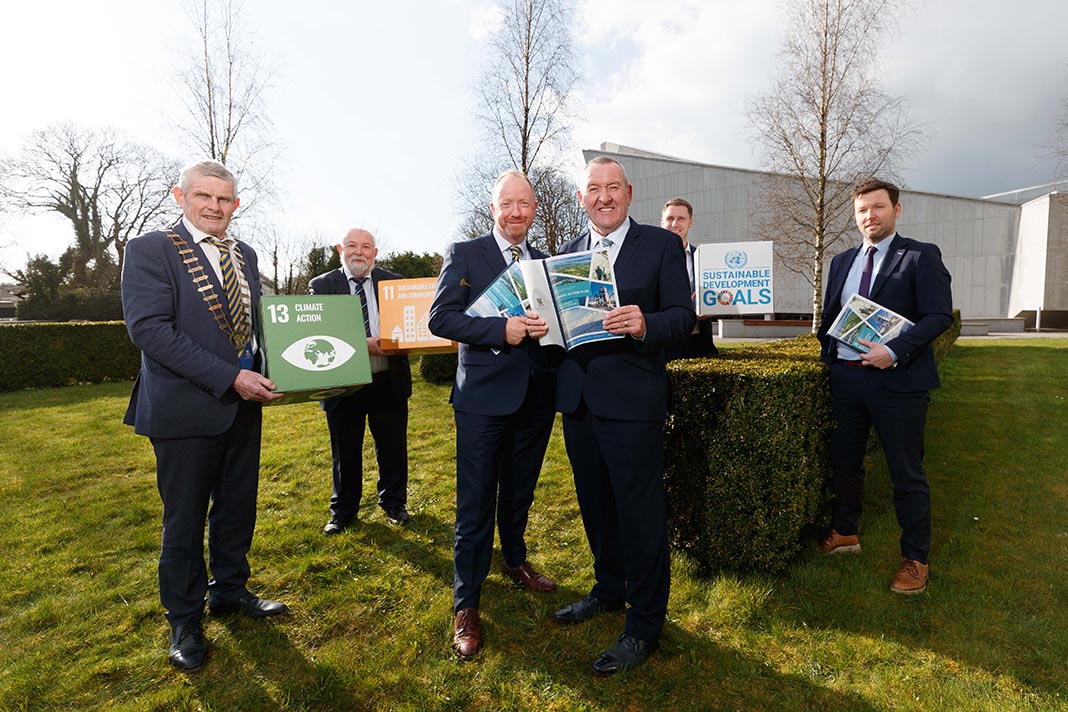Minister for the Environment, Climate and Communications, Eamon Ryan TD, will today attend the official launch event for the Local Authority Climate Action Plans in the Old Ground Hotel in Ennis, County Clare.
All 31 local authorities, including Clare, have been preparing their local climate plans over the past year and all plans have now been adopted by the elected members. The launch was organised by CARO, Climate Action Regional Offices.
The event includes a day of study visits to interesting climate projects in County Clare and gave participants the opportunity to meet colleagues across all local authorities and share learning and experiences. Projects to be visited include the Falls Hotel, Hometree farm, Lahinch Leisure Centre, Lahinch Beach Coastal Defences. There were also talks from Geopark staff at the Cliffs of Moher.
Clare County Council, which published its plan last month, will set out its vision in its climate action plan to be a national leader in climate action, supporting a sustainable low-carbon economy and climate resilient, biodiverse communities and businesses.
The local authority carried out an in-depth consultation with local residents and over 400 items of feedback were given by individuals, community groups, businesses and government agencies and departments during a two-phase public consultation process. 70% of respondents reported that they are worried about climate change and 76% believe they have a role to play. There was also a survey aimed at students to give them the chance to provide insights and recommendations. This showed that students are more worried about climate change than the general public but also more confident that their actions can make a difference.
Clare’s climate actions are set out in five strategic goals. Examples of actions include supporting the implementation of the Shannon Estuary Taskforce Report which includes developing a Maritime Training Centre of Excellence in Kilrush, developing feasibility reports into district heating for Ennis and Shannon, supporting the delivery of an efficient and reliable public bus system for Ennis, and support an increase in the number of farmers partaking in the Teagasc Signpost Programme. It also commits to identifying potential biodiversity opportunities for tree planting and woodland creation with the local authority’s landbanks.
Its Decarbonising Zone is the Loop Head Peninsula and specific areas of opportunity and actions are set out for the peninsula in the plan. Clare County Council will also shortly launch a quarterly Clare Climate Action Newsletter which provides updates on climate action in the county and gives details on local events and guidance. It has also partnered with Tipperary Energy Agency to deliver accessible and informative online energy webinars.
Speaking about the event and local authorities’ role in climate delivery, Minister Ryan said: “The climate is changing more quickly and unpredictably than scientists expected. We can see the impacts all around us – flooding, heatwaves, droughts. Local government has a key role to play in tackling climate change. They act as local leaders, champions and work closely with communities on the ground across a range of key areas, from housing to transport. They use their extensive knowledge of the natural and built environments in their areas to make a real difference.
“The new local authority climate action plans will enhance local government’s ability to act. For the first time, all the climate-related actions have been brought together into one document, serving as a focal point and the manual for each local authority and their climate journey. These plans will, over time, help us as a country to meet our national climate targets and will bring extra benefits such as making our air cleaner, our streets and public spaces quieter, and bringing more biodiversity and green spaces into where we live.”
Speaking on behalf of the local government sector John McLaughlin, Chair of the County and City Management Association Climate Action, Transport, Circular Economy, and Networks Committee said:
“Each local authority climate action plan was developed to respond to the unique challenges and opportunities of its area. The plans are based on research, consultation, and real understanding, and that is why they will have a significant impact in our cities and counties, and collectively for Ireland. Local authorities have been taking a lead on climate action for some time and now with 31 plans in place, we can build on this in a strategic, integrated and measurable way.
“I am delighted to see members of the climate teams from the 31 local authorities gathered in Clare today to collaborate and learn from each other. They will all play a vital role in driving the climate action plans forward, supporting across all local authority departments to help achieve our targets.”
Pat Dowling, Chief Executive of Clare County Council, added:“Clare County Council understands that we must lead by example. The target of a 51% reduction in Clare County Council’s own emissions and a 50% energy efficiency increase by 2030 represents significant challenges to this organisation, challenges we are prepared to meet.”
Completing the local climate plans is a milestone for the local government sector. Collectively there are almost 4,000 actions set out across all the local plans. They list practical climate measures to be completed in each local authority area over the next five years.
The plans demonstrate the ambition, focus and commitment of each local authority to reduce carbon emissions and improve the quality of life for people living, working and studying in each county.
Local authorities have worked over the past 12 months to engage with citizens, local businesses, public bodies and community organisations to inform their thinking around actions and priorities. Whilst working to national guidelines with set parameters, each plan is bottom-up and locally created; each plan is tailored to its local area.

Over the past two years each local authority has received funding from Government to assist them with developing their local plans, totalling almost €8 million, and this set to continue over the coming years.
The local authority climate action plans will help local authorities to address, in an integrated way, the mitigation of greenhouse gas emissions and climate change adaptation and strengthen the alignment between national climate policy and the delivery of effective local climate action.
Each climate plan is built on a strong evidence base. To help inform the plans, all local authorities developed a Climate Change Risk Assessment which sets out the likely risks is terms of climate change, such as increased rainfall or flooding. They also did a Baseline Emissions Inventory which calculates the emissions within the local authority area and sets out emission by sector such as transport, the built environment and agriculture.
The local climate plans will be closely monitored by the local authorities to ensure that their projects are on track and they will develop implementation plans with more detail on delivery. They will report to the local government sector and the supporting department, the Department of the Environment, Climate and Communications, on key indicators.
The launch also served as a networking event for the local authority staff, who have been writing the climate plans.
